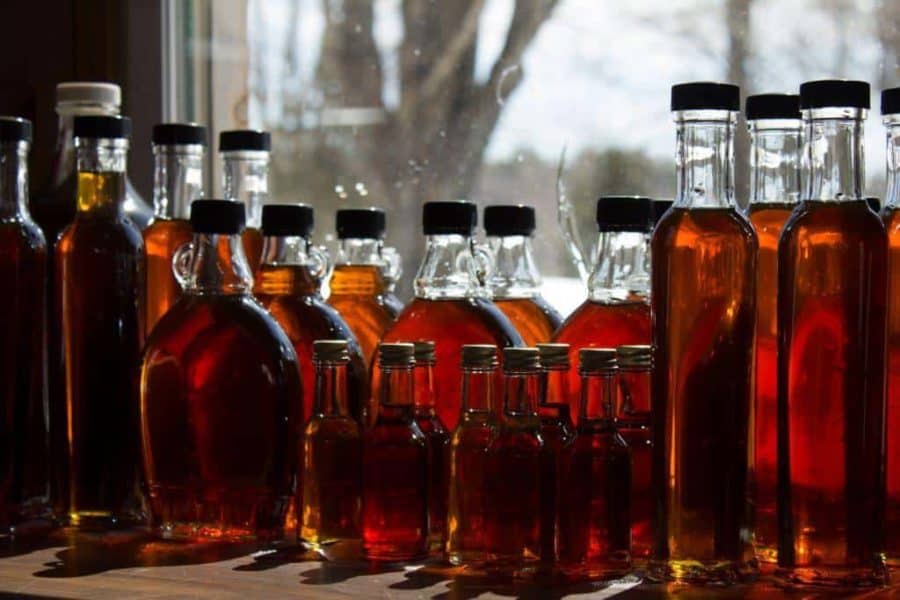Maple syrup production, one of New England’s cultural icons and a key economic component of the region, will shift northward during the next century due to rising temperatures that will drastically change the tapping season and reduce the quality of the sap, a new study says. The report, from researchers at the University of Massachusetts Amherst, the U.S. Geological Survey and colleagues in News Hampshire, Virginia, Indiana, Montana and Canada, finds that, by 2100, the region of maximum maple syrup flow will shift northward by hundreds of miles benefiting producers in Canada and lowering production and quality in the Eastern United States.
The paper also says the maple syrup industry in most of New England, except for Northern Maine, is likely to drop by half by the end of this century due to changes in the climate. The industry supports thousands of producers and provides permanent and seasonal income streams to local farmsteads and indigenous communities who have historically used maple as a food source and in trade.
The study, published in the journal Forest Ecology and Management, is based on observations of sap at six locations over a 2-to-6-year period with the emphasis on the climate sensitive components of sugar content and sap flow. The researchers found that the timing of sap collection advanced as the mean temperature in January through May increased and sugar content declined as temperatures in May through October rose.
The researchers say, “The region of maximum sap flow is expected to shift northward by 400 kilometers, from near the 43rd parallel to the 48th parallel by 2100. Our findings suggest climate change will have profound effects on syrup yield across most of sugar maple’s range; drastic shifts in the timing of the tapping season accompanied by flat to moderate increases in syrup yield per tap in Canada contrast with declines in syrup yield and higher frequencies of poor syrup production years across most of the U.S. range.”
The report, “Finding the Sweet Spot: Shifting Optimal Climate for Maple Syrup Production in North America,” was written by Joshua Rapp, Harvard Univerity’s Harvard Forest in Petersham, Mass., and UMass Amherst, David Lutz, Dartmouth College, Ryan Huish, University of Virginia’s College at Wise, Boris Dufour, Université du Québec à Chicoutimi, Selena Ahmed, Montana State University, Toni Lyn Morelli, UMass Amherst and the U.S. Geological Survey’s Northeast Climate Adaptation Science Center, and Kristina Stinson, UMass Amherst department of environmental conservation.
“The project is an example of translational ecology, with the concerns of tribal and other independent syrup producers driving the project from the beginning,” says Morelli. “These results fit into a broader framework of helping resource managers and tribal nations adapt to the impacts of climate change that is the focus of the work that we do. Moreover, it’s an important example of looking at the impacts of climate change on culture and livelihoods in the northeast.”
The study’s scientific observations were done at six locations in the U.S. and Canada with the help of more than 80 people who did data collections. The research was funded by a two-year, $150,000 grant from the USGS.
The data collection sites were at Divide Ridge in Southwestern Virginia and Southernmost Maple in Central Virginia, the Indiana Dunes National Park in Indiana, the Harvard Forest in Petersham, Massachusetts, the Dartmouth Organic Farm in New Hampshire and in Chicoutimi, Québec.
Other findings from the report include: “Projections indicated dramatic and mostly negative changes in syrup production per tap by the end of the century. Sites in Virginia and Indiana were projected to produce almost no syrup by the end of the century, while sites in Massachusetts and New Hampshire were projected to produce half as much as in the historical period on average. Only at the site in Quebéc site do projections support an increase in syrup production, with a doubling occurring by the end of the century on average.”
The paper says maple syrup production has been increasing approximately 10 percent annually in the U.S. for the past decade with stable high prices, largely held in place due to market concentration and supply management in Québec.

